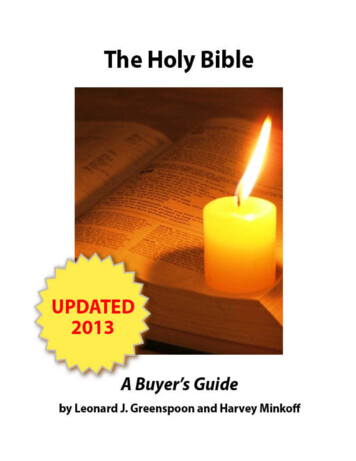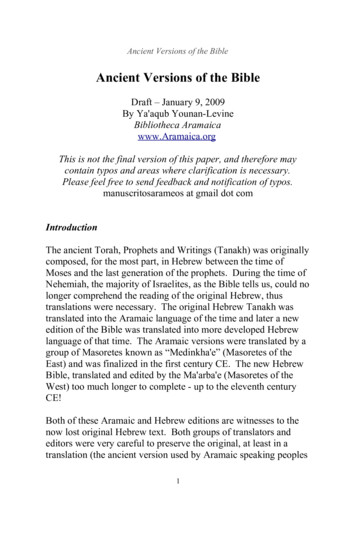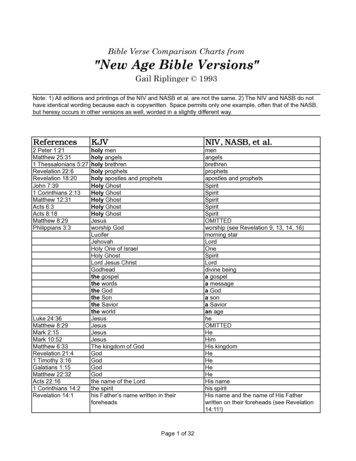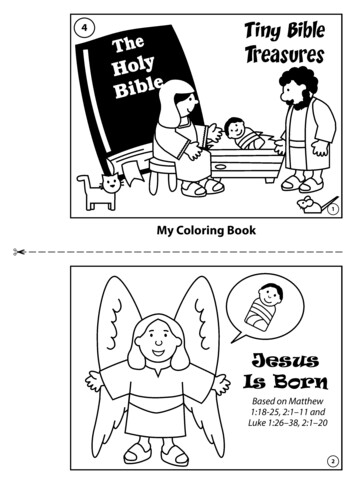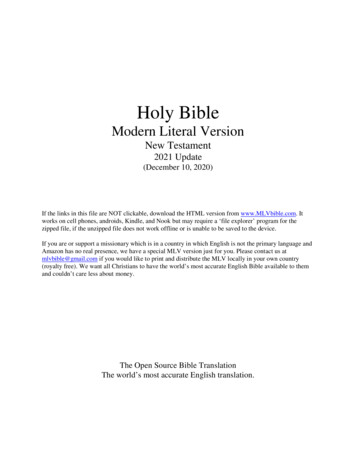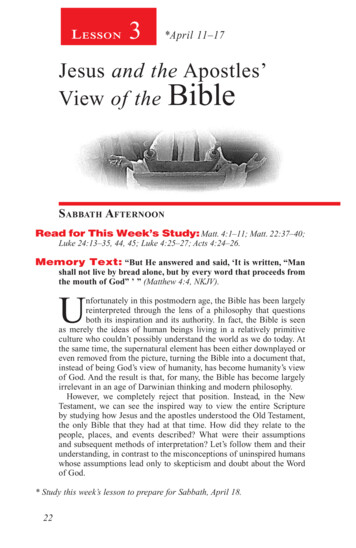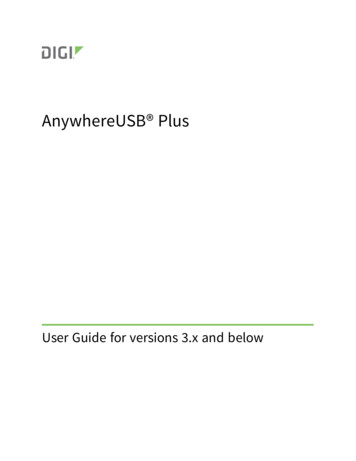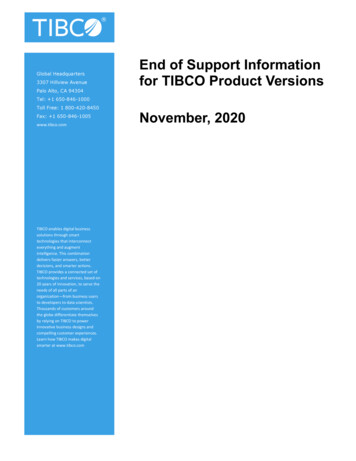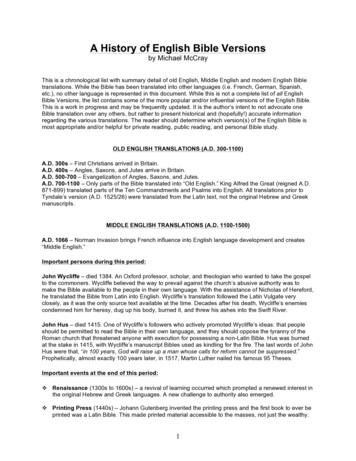
Transcription
A History of English Bible Versionsby Michael McCrayThis is a chronological list with summary detail of old English, Middle English and modern English Bibletranslations. While the Bible has been translated into other languages (i.e. French, German, Spanish,etc.), no other language is represented in this document. While this is not a complete list of all EnglishBible Versions, the list contains some of the more popular and/or influential versions of the English Bible.This is a work in progress and may be frequently updated. It is the author’s intent to not advocate oneBible translation over any others, but rather to present historical and (hopefully!) accurate informationregarding the various translations. The reader should determine which version(s) of the English Bible ismost appropriate and/or helpful for private reading, public reading, and personal Bible study.OLD ENGLISH TRANSLATIONS (A.D. 300-1100)A.D. 300s – First Christians arrived in Britain.A.D. 400s – Angles, Saxons, and Jutes arrive in Britain.A.D. 500-700 – Evangelization of Angles, Saxons, and Jutes.A.D. 700-1100 – Only parts of the Bible translated into “Old English.” King Alfred the Great (reigned A.D.871-899) translated parts of the Ten Commandments and Psalms into English. All translations prior toTyndale’s version (A.D. 1525/26) were translated from the Latin text, not the original Hebrew and Greekmanuscripts.MIDDLE ENGLISH TRANSLATIONS (A.D. 1100-1500)A.D. 1066 – Norman Invasion brings French influence into English language development and creates“Middle English.”Important persons during this period:John Wycliffe – died 1384. An Oxford professor, scholar, and theologian who wanted to take the gospelto the commoners. Wycliffe believed the way to prevail against the church’s abusive authority was tomake the Bible available to the people in their own language. With the assistance of Nicholas of Hereford,he translated the Bible from Latin into English. Wycliffe’s translation followed the Latin Vulgate veryclosely, as it was the only source text available at the time. Decades after his death, Wycliffe’s enemiescondemned him for heresy, dug up his body, burned it, and threw his ashes into the Swift River.John Hus – died 1415. One of Wycliffe’s followers who actively promoted Wycliffe’s ideas: that peopleshould be permitted to read the Bible in their own language, and they should oppose the tyranny of theRoman church that threatened anyone with execution for possessing a non-Latin Bible. Hus was burnedat the stake in 1415, with Wycliffe’s manuscript Bibles used as kindling for the fire. The last words of JohnHus were that, “in 100 years, God will raise up a man whose calls for reform cannot be suppressed.”Prophetically, almost exactly 100 years later, in 1517, Martin Luther nailed his famous 95 Theses.Important events at the end of this period: Renaissance (1300s to 1600s) – a revival of learning occurred which prompted a renewed interest inthe original Hebrew and Greek languages. A new challenge to authority also emerged. Printing Press (1440s) – Johann Gutenberg invented the printing press and the first book to ever beprinted was a Latin Bible. This made printed material accessible to the masses, not just the wealthy.1
EARLY MODERN ENGLISH TRANSLATIONS (A.D. 1500-1700) Protestant Reformation (1517-1648) – Martin Luther and those who followed had a tremendousdesire to get the Bible into the hands of the common people. If people could read the Scripture in theirnative language, they could understand God’s Word for themselves.1525/6 – Tyndale’s New Testament. William Tyndale translated the New Testament into English fromGreek, using Desiderius Erasmus’ 1516 Greek version. Tyndale was the first man to ever print the NewTestament in the English language. He was translating the Old Testament at the time of his death as amartyr in 1536. Tyndale’s last words were, “Oh Lord, open the King of England’s eyes.” This prayer wouldbe answered just three years later in 1539 when King Henry VIII finally allowed, and even funded, theprinting of an English Bible known as the “Great Bible.”1535 – Coverdale Bible. Miles Coverdale completed and published the first complete Bible in English.Coverdale did not translate the Bible directly from the Greek and Hebrew texts, but he used Luther’sGerman translation, more than one Latin text, and Tyndale’s Old Testament portions. This translationplaced the Apocrypha – those books the Roman Catholic Church accept as canonical but whichProtestants reject – at the end of the Old Testament rather than interspersed throughout the OldTestament. All Protestant Bibles that followed, if they included the Apocrypha, placed these books as anappendix, just like Coverdale had done.1537 – Matthew’s Bible. This was a complete English Bible by John Rogers, whose pen name wasThomas Matthew. He was a friend of William Tyndale. This Bible received royal sanction by King HenryVIII. Rogers combined Coverdale’s Old Testament with Tyndale’s New Testament. Rogers also addedabout 2000 notes, many of them controversial. This was the first revision of Tyndale’s New Testament.1539 – Great Bible. The Great Bible was a revision of Matthew’s Bible by Coverdale and was the firstEnglish Bible “authorized” for public reading. In September 1538, King Henry VIII ordered an EnglishBible to be placed in every church, specifying that each church was to have in its possession “one book ofthe whole Bible of the largest volume in English.” The churches began to use Matthew’s Bible but itcontained many controversial notes. Therefore, because of the king’s order, Oliver Cromwellcommissioned Miles Coverdale to publish a new Bible that was to be larger than Matthew’s Bible. Thisversion was thus called the Great Bible – because of its enormous size. Coverdale took Matthew’s Bible,revised it, and deleted the notes. The Great Bible was also known as the Cromwell Bible, theWhitchurch’s Bible (after its first English printer), and the Chained Bible, since it was chained to preventremoval from the church. The Great Bible became the second revision of Tyndale, after Matthew’s Bible.1560 – Geneva Bible. In 1553 Mary Tudor ascended the throne and began to systematically burn bothBibles and Protestants. Many Protestant scholars fled from England to Geneva, where the famousReformed theologian, John Calvin, was living. One Reformer, William Whittingham (John Calvin’sbrother-in-law), completed his translation of the New Testament in 1557. He and other Reformers workedon the whole Bible, and three years later, produced the Old Testament and a revised New Testament.The Geneva Bible was produced by Protestant scholars in Geneva, using Theodore Beza’s Latintranslation, Hebrew texts, Greek texts, and Tyndale’s work. The Geneva Bible had several significantfeatures, which eventually led to the reputation that it was the very first study bible: It was the first translation done by a committee.It was the first English Bible with verse divisions, which became the basis for all “versification” inlater English Bibles.It was the first Bible to use italics extensively for words that were not in the original text.It contained copious notes in the margins, some doctrinal, and others simply explanatory.It was the Bible of Shakespeare, John Bunyan and the Bible the Pilgrims took to America.It influenced the King James Version (KJV) enormously. The KJV translators employed theGeneva Bible as much as Tyndale’s version to translate the KJV.2
It had a long and stellar history. Fifty years after the KJV was published, the Geneva Bible wasstill the most popular Bible in England.1568 – Bishops’ Bible. This was revision of the Great Bible and was the second “authorized” Englishversion, authorized by the Church of England as their official translation. The Geneva Bible could not beused in ecclesiastical settings because it was too Calvinistic for the English clergy and was so popularamong the lower classes that it was deemed politically incorrect to use from the pulpit. This translationwas called the Bishops’ Bible because bishops produced it. However, it never gained popularity and itslast printing occurred in 1606. Ironically, though, this translation was the official base version the KJVtranslators were directed to use in making the KJV. However, only about an estimated four percent of theKJV’s wording is from the Bishop’s Bible.1582/1610 – Rheims-Douai Bible. This was a Roman Catholic translation based on the Latin Vulgate.The Council of Trent (1544) had decreed that Bibles should be translated from Latin. It was not untilVatican II that this order was rescinded. Since all of the previous English Bible translations were“protestant” Bibles, the Catholics wanted their own English Bible. This was not because they agreed thatlay people should have a Bible in their own language. Rather, since they could not stop laypeople fromreading the Bible, they at least wanted them to read a “correct” version of it. As with the Geneva Bible, theRheims-Douai translators inserted many notes and annotations into the margins and chapter ends, withthe difference, that they promoted Roman Catholic doctrine. The Rheims-Douai Bible also had someinfluence on the wording of the KJV.1611 – King James Version (KJV or Authorized Version). For much of England, there were twocompeting Bible translations: the Bishops’ Bible that was used in the churches, and the Geneva Bible thatwas read in the homes. By far, the Geneva Bible was the more popular one. The clergy desired to have atranslation in the churches that would be revered by the masses. The KJV was commissioned by KingJames I of England and was translated by approximately 50 biblical scholars. The rules of procedures fortranslating the KJV was that the Bishop’s Bible was to be followed as much as possible, along withcertain other translations (Tyndale’s, Matthew’s, Coverdale’s, the Great Bible and the Geneva Bible) ifthose versions agreed better with the text. Somewhat surprisingly, the Rheims-Douai version of the NewTestament, which was based on the Latin Vulgate, also had some impact on the KJV. Another rule fortranslating was the KJV must not have any marginal notes – except for those that explained the Greekand Hebrew words or cross-referenced other passages. The translating committee was divided into sixpanels: three for the Old Testament, two for the New Testament, and one for the Apocrypha. When onepanel finished a revision of a book, it was sent to the rest for their suggestions.The original edition of the KJV included a preface by the translators (usually omitted in modern editions ofthe KJV), which described the principle of Bible translation and explained that the KJV was really arevision, not a new translation. In fact, the translators based their work on existing published texts. Theaim of the revisers (translators) was clearly stated in the preface: “ we never thought from the beginning,that we should need to make a new Translation, nor yet to make of a bad one a good one but to makea good one better, or out of many good ones, one principal good one.” The omission of this preface hasprobably been one of the reasons why some people believe the KJV is the only inspired Bible, somethingthe KJV translators would hardly agree. The purpose of the KJV can also be summed up in anotherstatement from the preface, which was “to deliver God's book unto God's people in a tongue which theyunderstand.” Therefore, the KJV was designed to be contemporary (or current) with the English-speakingthpeople of the 17 century. The KJV went through numerous revisions after the first printing and two largeroverhauls in 1629 and 1638. Altogether, nearly 100,000 changes have been made to the 1611 edition ofthe KJV. Most KJV Bibles published today in America are actually the 1769 revision of the 1611 edition.Although it would take fifty years after 1611 for the KJV to overtake the Geneva Bible in popularity, iteventually became the preferred version for both public and private use, superseding both the Bishops’Bible and the Geneva Bible. There are several reasons why the KJV was so popular and wentunchallenged for so long:3
Unlike the Geneva Bible, it was produced in England.Unlike the Bishops’ Bible, it appeared in both folio size (large) and quarto size (small). It couldtherefore compete with the Geneva in the home as well as in the church.It was adopted and promoted by the Church – without the stigma of persecution found with theGeneva Bible, and without the stigma of the poor literary quality of the Bishops’ Bible.Unlike the Geneva Bible, it did not have numerous marginal notes from a particular theologicalperspective.It involved approximately 50 biblical scholars, whereas the Bishops’ Bible had been translated bynine men and the Geneva Bible by a small committee.It had excellent English, unlike the Bishops’ Bible, and was more lyrical and rhythmic than theGeneva Bible.It was a compromise between various factions within England – including High Churchmen andPuritans, and to a degree, between Protestants and Catholics. It was based on the Bishops’ Bible(to satisfy the High Churchmen), looked a lot more like the Geneva Bible, and even borrowedsome from the Rheims-Douai (Catholic).Finally, it had the financial and political backing of the English throne.Essentially, the KJV went unchallenged due to a mixture of political influence, religious compromise, andliterary power. It is worth noting that the first English Bible to be printed in America was a King JamesVersion, by Robert Aitken in 1782. Robert Aitken’s 1782 KJV Bible was also the only Bible everauthorized by the United States Congress.MODERN ENGLISH TRANSLATIONS (A.D. 1800 – Present)1833 – Noah Webster’s Translation. Just a few years after producing his famous Dictionary of theEnglish Language, Noah Webster produced his own modern translation of the English Bible. Likeprevious translators had believed, Webster wanted to make the
The Great Bible was a revision of Matthew’s Bible by Coverdale and was the first English Bible “authorized” for public reading. In September 1538, King Henry VIII ordered an English Bible to be placed in every church, specifying that each church was to have in its possession “one book of the whole Bible of the largest volume in English.” The churches began to use Matthew’s Bible but it
